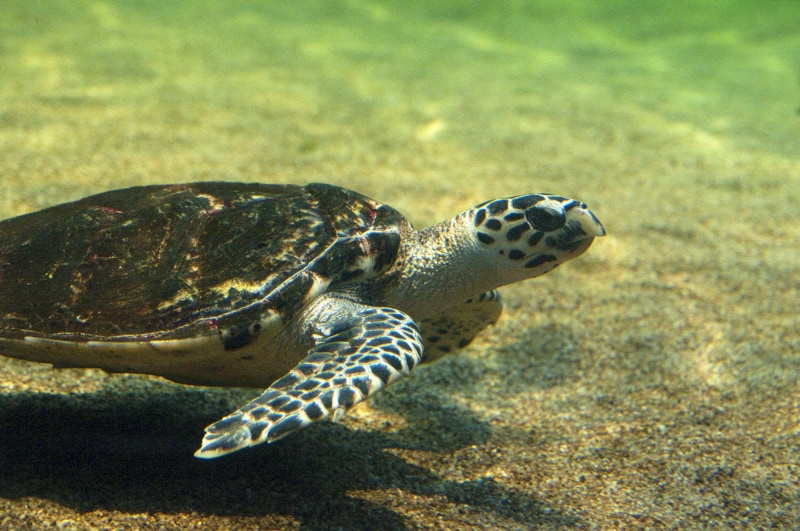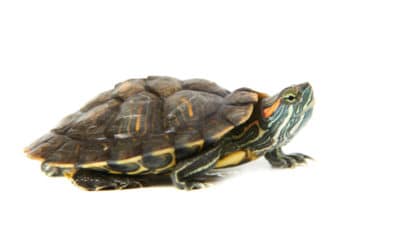There are quite a lot of animals that are color blind or really close to it. One of the best examples is dogs. Even if they are not completely colorblind creatures, their ability to distinguish some of the colors is heavily limited. One of the latest “pet trends” is a turtle, since having it is not time-demanding and does not require heavy investments from us – besides the obvious initial expenses. However, are these creatures colorblind or as bad in distinguishing colors than some of the other pets? Well, not exactly.
You see, turtles can see color. Moreover, they are even better at differentiating some of the taints than humans. But how is it possible that turtles are so great at seeing colors? Well, it is all due to the predecessor that turtles share with birds. You see, there is a special gene, known as the red gene, that allows them to see more colors than people see. But how does it work? What exactly do turtles see? Can they see in the dark?
Well, surely you’ve got a lot of questions. Well, it’s not surprising, since having a turtle as a pet demands at least basic knowledge about these creatures. Just to make sure that we understand them to a certain degree and know what’s best for them. This is why in this article I would like to share my experience and present to you some of the most valuable information that I gathered regarding turtles’ vision and what they actually are capable of.
How do turtles see?
Let’s start off with something relatively easy. So, from the beginning we know that they are good at seeing things. It is mainly due to the fact that they are equipped with a special gene that provides them with some extra shades of red. Interestingly, their eyes are quite similar to ours. Not from the biological point of view, because turtles have eyes on the sides of their head, while people have forward-facing eyes.
The similarity that I am talking about concerns the way the eyes of humans and turtles work. During the day, they can witness almost everything that is at their eyesight. However, at night, they see almost nothing. Still, it is possible for them to adjust to the environment and, just like humans, see at least the edges of objects. But more about night vision later.
For now, you need to understand that turtles, in contrast to many other animals, possess a very wide range of the colors palette. As a result of that, it is very easy for them to differentiate objects.
What can turtles see in the dark?
Some people believe that turtles are nocturnal animals and prefer doing their activities at night. Well, this misconception is quite common because turtles quite often do not sleep the entire night. However, it is not due to the fact they prefer nightlife. The reasoning behind is that they only need 4 hours of sleep a day. It means that they simply wake up and wait for the sun to come up.
The truth is that they are very bad at seeing at night. This is all due to the fact that they do not have a special membrane in their eyes (known as tapetum lucidum). One can notice that while taking a photo of the turtle – the eyes of an animal with tapetum lucidum should glow in the dark. Turtles’ eyes don’t glow, so no membrane for night vision for them.
Still, the fact that they have CYP2J19, which is a gene from birds that turtles got from their ancestors mean that their vision in the dark is slightly better than humans – mainly due to the fact that because of such addition they can differentiate more variants of red color than humans. As a result, some of the objects are more outlined and, therefore, they can be easier to see.

How many colors can turtles see?
As far as the number is concerned, I do not have an exact number for you. You see, no one has because there have been a lot of different researches that tried to define the exact number of colors that these reptiles see. Nonetheless, we have to remember that turtles’ eyes have a larger number of cone cells than people. We’ve got three of them and each cone cell is capable of registering 100 colors. If we were to sum up all the combinations, then we’ve got 1 million colors.
Turtles, on the other hand, have four cone cells. Three standard ones, just like people, and an additional one. The one that is responsible for additional shades of red. Since people have three cone cells and it gives us a sum of 1 million different colors, then turtles with four cone cells will have 100 million different combinations.
Why do they see more colors than humans?
As I mentioned earlier on, we do not have four cone cells just like turtles. Because of that, our sight instrument is not as advanced as in the case of turtles. At least in terms of colors that we see. Three cone cells that humans have provide us with “only” 1 million colors. Luckily for turtles, they possess the redness gene, which guarantees them a much more diverse sight in terms of shades of red.
Interestingly, some time ago, in the past, humans were capable of seeing exactly the same amount of colors or even more! It was all due to the fact that they possessed genes similar to the ones turtles have nowadays. However, with time and as evolution proceeded, humans got rid of genes responsible for extra colors because they were considered not necessary for survival.
Obviously, getting rid of the gene responsible for “extra” colors was a good idea for humans, since we had many different tools to spot food or predators. Besides that, we started to live in communities that were easier to defend. Turtles, on the other hand, use the extra colors to spot food or predators. As a result of that, they treated the gene as an important part of their survival.
Can turtles see underwater? If so, what colors do they see?
Yes, turtles can see underwater. The interesting fact is that the vision of turtles while underwater is the same as on land. Because of that, they are great at hunting maritime life like, for example, frogs, slugs or small fish. As far as the colors are concerned, they are capable of seeing the same colors as on land. It means that the fourth gene and additional shades of red will surely be quite crucial for faster and more accurate recognition of prey and predators.
Obviously, there are some limitations as far as underwater vision is concerned. For example, turtles will not be able to see very clearly when the water is dirty. Besides that, staying underwater during night will also influence their sight. Still, they are much better at seeing underwater than humans and some other maritime animals.
Noteworthy is the fact that turtles use a very simple trick to clear their eyes and don’t worry about dirty water once they leave it. You see, turtles cry. Their tears are not the same as humans. They do not do that because their feelings were hurt or they are sad. If you see a turtle that is crying, then most definitely it is simply clearing its eyes.
Now you know if turtles can see colors!
Turtles are astonishing animals that surprise us with many different behaviors. Besides that, their biological characteristics are quite diverse and, therefore, a lot of owners who have never had a turtle as a pet before will be surprised by different things that their reptiles do. Even if some animals we keep in home are colorblind or quite close to that, turtles are not one of them.
Turtles see much more colors than people because of the additional gene. It is quite a crucial part of survival because the redness gene allows them to recognize prey and predators much clearer. Therefore, turtles can definitely see colors and they are even better at seeing them than humans.
Submit your review | |





















